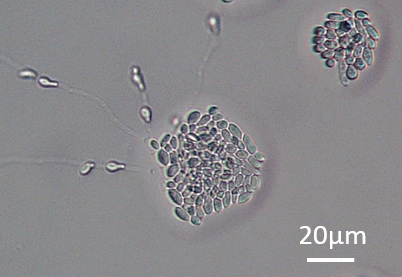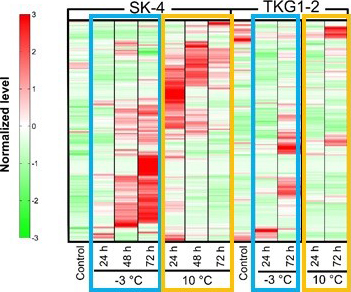National Institute of Polar Research
[Research Highlight] Antarctic yeast's survival strategies: consuming energy to prevent from intracellular freezing
Released on July 6, 2016 (in Japanese)
Posted on October 13, 2016
National Institute of Polar Research
Research suggests Antarctic yeast Mrakia blollopis pays huge energy costs to resist cold stress as it grows in subzero temperatures.
Fungi that inhabit Antarctica can grow even at subzero temperatures. These fungi act as decomposers and play a significant role in the nutrients cycle in polar-region ecosystems. Yet, the metabolic response of such fungi to the cold stress of subzero temperature conditions is not entirely clear.
Dr. Masaharu Tsuji (National Institute of Polar Research, Japan) is shedding new light on cellular mechanisms of life in extreme polar environments. Studying two strains of the Antarctic basidiomycetous yeast Mrakia blollopis (Figure 1) with different growth characteristics under low temperature conditions to measure metabolic responses to subzero temperature conditions, he found that strain SK-4, which is well-adapted to subzero conditions, showed active metabolic pathways such as cell division and cell wall synthesis. He also discovered that SK-4 accumulated high levels aromatic amino acids including tryptophan. Aromatic amino acids are known to improve cell growth at low temperatures and among the most costly compounds for the cell to synthesize in terms of ATP requirement. Strain TKG1-2 however, which did not grow efficiently at subzero temperatures, showed no clear changes in metabolic response nor any distinctive accumulation of metabolites induced by cold stress.
His findings suggest that Mrakia blollopis consumes large amounts of energy during growth to help it cope with cold stress as it grows in subzero temperatures.
He says, "ATP is an energy source for organisms. It appears that microbial Antarctic yeast cells prevent from intracellular freezing by sacrificing this vital energy resource” and adds that “I will be looking at a wider variety of Antarctic fungi to determine whether cold stress induces changes in metabolism and gene expression."

Figure1: Antarctic yeast Mrakia blollopis SK-4
Credit: NIPR

Figure2: shows the heat map generated from research data. A heat map analysis is one approach to graphically representing numeric data by color shading. Each horizontal bar in the figure represents a metabolite. The deeper the red, the more metabolite produced; the deeper the green, the less metabolite produced.
In the case of strain SK-4, which is well-adapted to subzero conditions, the metabolite-response pattern for cold shock (-3°C, outlined by the light blue border) was clearly divided from the pattern at 10°C (outlined by the orange border; by contrast, the response pattern of TKG1-2, which did not grow efficiently at subzero temperatures, at 10°C (outlined by the orange border) was separated from the pattern at -3°C (outlined by the light blue border) only at the 72-h cultivation time point..
Credit: NIPR
Published Paper
Masaharu Tsuji (NIPR), Cold-stress responses in the Antarctic basidiomycetous yeast Mrakia blollopis, Royal Society Open Science, 3: 160106 (2016)
URL : http://dx.doi.org/10.1098/rsos.160106
DOI : 10.1098/rsos.160106
Acknowledgement
This study was supported by a JSPS Grant-in-Aid for Research Activity Start-up grant (No. 15H06825), Young Scientists (A) (no. 16H06211) and a Research Organization of Information and Systems, Japan (ROIS), grant for Young Scientists.
Contact
Public Relations Section, National Institute of Polar Research
E-mail: kofositu@nipr.ac.jp








